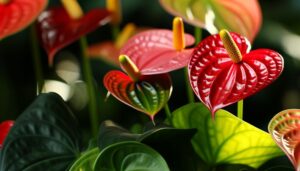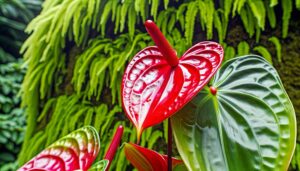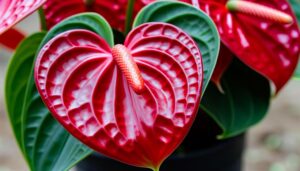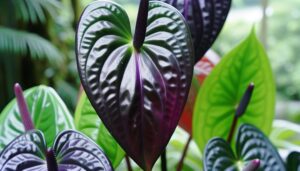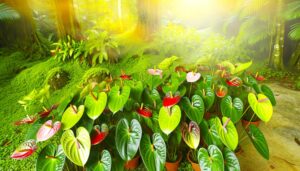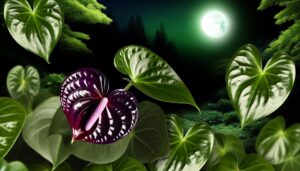Why Is Anthurium Jenmanii ‘King of Kings’ So Special?
Anthurium Jenmanii ‘King of Kings’ stands out due to its luxuriant, coriaceous leaves over 60 cm long. These leathery leaves, dark green with pinnate venation, optimize photosynthesis and reflect light thanks to a thick cuticle.
Originating from South American rainforests, it requires high humidity and well-draining, organic-rich soil. This rarity, named after botanist George Samuel Jenman, thrives in Central and South America’s isolated habitats, making it coveted among collectors.
Its robust growth also helps in air purification, contributing to its esteemed status. To uncover more unique traits and care tips, continue on this path.
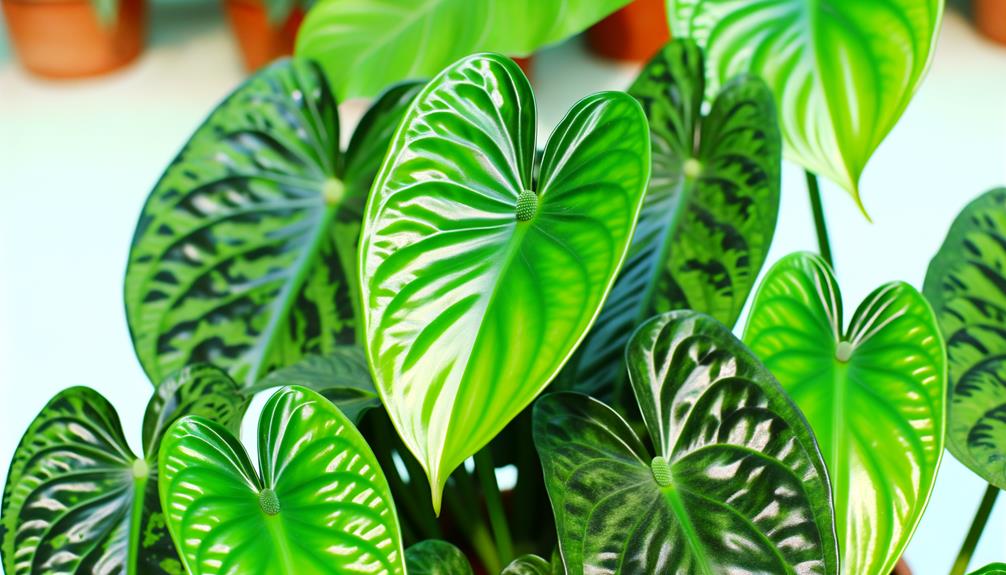
Key Takeaways
- Striking Leaf Appearance: Glossy, leathery leaves with dark green pigmentation and prominent veining provide a visually stunning, tropical look.
- Impressive Leaf Size: Leaves can grow over 60 cm, optimizing photosynthesis and adding ornamental value.
- Rarity and Exclusivity: Limited natural habitat and specialized growth requirements make it highly sought after by collectors.
- Air Purification: Acts as a natural air filter, improving indoor air quality by removing toxins.
- Low Maintenance: Hardy nature with minimal care needs, making it an attractive option for plant enthusiasts.
Striking Leaf Appearance

The Anthurium jenmanii ‘King of Kings’ boasts broad, leathery leaves that exhibit a strikingly glossy sheen, which is a hallmark of this cultivar.
You’ll appreciate how its leaves’ adaxial surface reflects light, enhancing its ornamental appeal.
The leaves’ coriaceous texture results from the thick cuticle layer, providing both durability and aesthetic charm.
Anthurium jenmanii’s venation pattern is pinnate, which means the secondary veins arise from a central midrib, creating an intricate network.
This pattern not only contributes to structural integrity but also aids in efficient photosynthesis.
The rich, dark green pigmentation results from abundant chlorophyll, optimizing light absorption.
With such characteristics, Anthurium jenmanii ‘King of Kings’ stands out as a specimen that offers both visual and functional excellence.
Impressive Leaf Size
You’ll immediately notice the Anthurium Jenmanii ‘King of Kings’ boasts broad, luxurious foliage that can reach impressive dimensions, often spanning over 60 cm in length.
The unique leaf texture, characterized by its thick, leathery surface, and prominent veining, enhances its majestic appearance.
Such substantial leaf size not only contributes to its ornamental value but also plays a role in its physiological functions, including photosynthesis optimization.
Broad, Luxurious Foliage
With its immense, glossy leaves, Anthurium jenmanii ‘King of Kings’ captivates botanists and plant enthusiasts alike. The foliage’s broad dimensions and lush appearance set it apart.
When you examine the leaves, you’ll notice:
- Leaf Width: The leaves can reach up to 30 cm in width, providing a bold visual impact.
- Leaf Length: Stretching up to 90 cm, these leaves command attention and create a striking presence.
- Leaf Shape: The ovate to lanceolate shapes enhance the plant’s majestic aesthetic.
These aspects make Anthurium jenmanii ‘King of Kings’ a true marvel in the plant kingdom. Its broad, expansive foliage not only adds a touch of luxury to any space but also showcases the plant’s robust health and importance.
Unique Leaf Texture
How does the unique texture of Anthurium jenmanii ‘King of Kings’ leaves contribute to its impressive size and overall allure?
The leaves of Anthurium jenmanii exhibit a coriaceous (leathery) texture, which gives them structural integrity and allows for significant size expansion without tearing.
This coriaceous quality results from thickened, lignified cell walls in the leaf epidermis, providing durability and resistance to environmental stressors.
The surface texture minimizes water loss through reduced transpiration, aiding in the plant’s overall growth.
The combination of substantial leaf size and resilient texture creates a visually striking appearance, making Anthurium jenmanii ‘King of Kings’ a true marvel in any collection.
You’ll find its robust, tactile leaves both unique and enchanting, offering an unmatched botanical experience.
Unique Care Requirements

To maintain Anthurium Jenmanii ‘King of Kings’ thriving, provide it with a consistent moisture level of 70-80%, as this mimics its native tropical rainforest environment. Ensure that the soil is a well-draining blend, rich in organic material.
The plant prefers indirect, bright light to avoid scorching its leaves. For peak growth, follow these steps:
- Moisture: Keep levels between 70-80% using a humidifier or pebble tray.
- Watering: Water when the top inch of soil feels dry, maintaining moisture without waterlogging.
- Fertilization: Use a balanced, water-soluble fertilizer monthly during the growing season.
Fascinating History
Delving into the fascinating history of Anthurium Jenmanii ‘King of Kings’, you’ll discover its origins trace back to the dense tropical rainforests of South America, where its unique characteristics were first documented by botanists.
Initially classified within the Araceae family, Anthurium Jenmanii boasts remarkable large, leathery leaves that captivate plant enthusiasts. Its discovery is attributed to 19th-century explorers who meticulously cataloged the flora.
The species name honors the botanist George Samuel Jenman, whose contributions to plant taxonomy were invaluable.
Through genetic studies, researchers have highlighted its adaptability to varying microclimates, a proof of its evolutionary success.
By understanding its roots, you gain a deeper appreciation for this regal species, embodying both botanical intrigue and the spirit of exploration.
Rarity and Exclusivity

Owing to its limited natural habitat and specialized growth requirements, Anthurium Jenmanii ‘King of Kings’ is considered a rare and exclusive species among plant collectors.
This exclusivity stems from several factors:
- Geographic Isolation: Native to specific regions in Central and South America, its natural occurrences are scarce.
- Specialized Microclimate Needs: Thriving in high humidity and stable temperatures, it’s challenging to replicate these conditions outside its native environment.
- Propagation Difficulty: The species requires precise conditions for germination and growth, making cultivation labor-intensive.
These factors contribute to its esteemed status. Collectors and enthusiasts value the Anthurium Jenmanii ‘King of Kings’ not just for its beauty but also for the meticulous care and expertise needed to grow it successfully. You’ll find owning one is a tribute to your dedication and skill.
Indoor Tropical Appeal
Anthurium Jenmanii ‘King of Kings’ brings a striking tropical allure to indoor spaces with its large, glossy, heart-shaped leaves and robust, upright growth habit.
The foliage, scientifically known as Anthurium, exhibits a deep green hue with a leathery texture that enhances its visual impact. Its aroid structure, characteristic of the Araceae family, ensures it flourishes in low-light environments, making it perfect for indoor cultivation.
You’ll appreciate its ability to purify air by removing toxins like formaldehyde and ammonia. The plant’s architectural form provides a focal point in any room, offering both aesthetic and functional benefits.
When you incorporate this exotic beauty into your home, you create a sanctuary that echoes the freedom and vibrancy of tropical rainforests.
Growth and Propagation
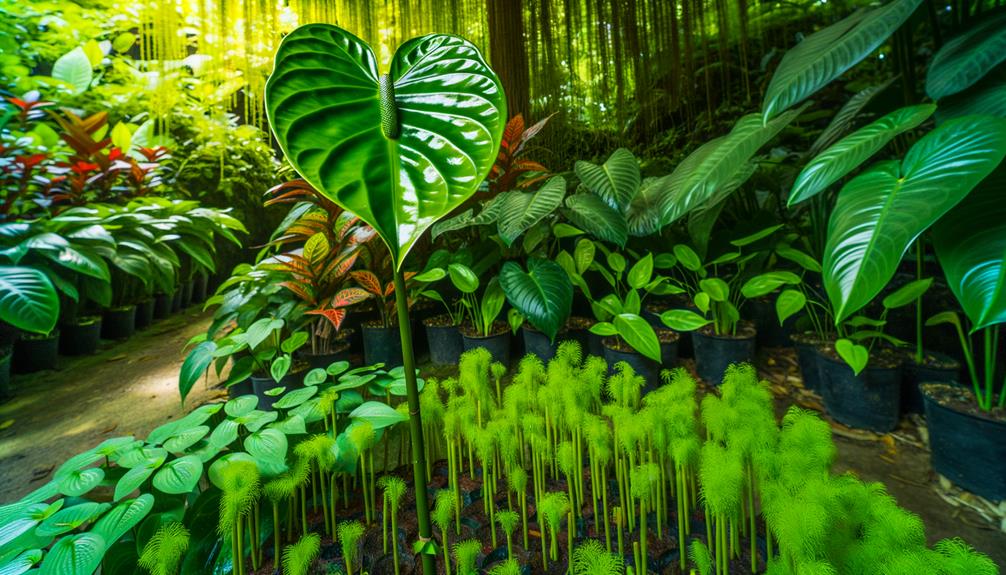
To cultivate Anthurium Jenmanii ‘King of Kings’ successfully, you’ll need to maintain specific environmental parameters including humidity levels above 60% and temperatures between 18-25°C.
Propagation is primarily achieved through stem cuttings, ensuring each section contains at least one node for best root development.
Utilize a well-draining medium composed of sphagnum moss and perlite to encourage healthy growth and prevent rot.
Optimal Growing Conditions
For best growth and propagation of *Anthurium jenmanii* ‘King of Kings,’ maintain a consistent temperature range between 70-85°F (21-29°C) and maintain high humidity levels above 60%. Optimal growing conditions are essential for this majestic species.
Guarantee your plant’s environment includes:
- Indirect sunlight: Direct sunlight can scorch the leaves, so place it in a spot with filtered light.
- Well-draining soil: Use a mix of orchid bark, perlite, and peat moss to prevent root rot.
- Regular watering: Keep the soil consistently moist but not waterlogged, allowing the top inch to dry out between waterings.
Propagation Techniques Explained
Understanding how to propagate Anthurium jenmanii ‘King of Kings’ requires mastering specific horticultural techniques that guarantee successful growth and reproduction. Primarily, you’ll employ division or stem cuttings.
For division, carefully separate offsets from the parent plant, ensuring each has roots. Use sterilized tools to avoid infections.
Plant divisions in well-draining, organic-rich soil. Stem cuttings, ideally 6-8 inches long, should feature at least one node. Dip cut ends in rooting hormone and plant in a humid, warm environment.
| Propagation Method | Key Steps |
|---|---|
| Division | Separate offsets, ensure roots, plant in soil |
| Stem Cuttings | Cut stem, apply rooting hormone, plant in humidity |
| Tools Needed | Sterilized knife, rooting hormone, potting mix |
Master these techniques, and you’ll proliferate these majestic plants effortlessly.
Common Issues and Solutions
While Anthurium Jenmanii ‘King of Kings’ is a robust plant, it still faces several common issues that require prompt and effective solutions to ensure its long-term health and vitality.
- Root Rot: This issue is typically caused by pathogens like *Phytophthora*. To prevent root rot, it is crucial to use well-draining soil and avoid waterlogging.
- Leaf Yellowing: The yellowing of leaves is often a result of nutrient deficiencies, especially nitrogen. Maintaining green and lush foliage can be achieved by using a balanced fertilizer.
- Pest Infestations: Common pests such as aphids, spider mites, and mealybugs can attack Anthurium Jenmanii ‘King of Kings’. Regularly inspecting the leaves and using insecticidal soap or neem oil can help control these pests effectively.
Popularity Among Collectors

You’ll find that Anthurium Jenmanii ‘King of Kings’ captivates collectors due to its rare and unique morphological characteristics. These include its large, glossy leaves and robust growth habit.
The high market demand for this species is driven by its limited availability and remarkable aesthetic appeal.
This demand often results in elevated prices. Consequently, its rarity and distinctiveness make it a coveted specimen in horticultural circles.
Rare and Unique Appeal
Collectors highly covet Anthurium jenmanii ‘King of Kings’ due to its distinct morphology and striking foliage, which set it apart from other Anthurium species. You’ll find its broad, glossy leaves and robust venation are truly unparalleled.
This plant’s unique attributes include:
- Leaf Morphology: The thick, leathery leaves exhibit a pronounced bullate texture, scientifically known as rugosity.
- Growth Habit: It has a compact rosette formation, allowing it to flourish in confined spaces without the need for extensive vertical growth.
- Aesthetic Coloration: The leaves’ deep green hue, coupled with their metallic sheen, offers an exotic visual appeal that’s hard to match.
These characteristics make Anthurium jenmanii ‘King of Kings’ a standout specimen in any collection, combining both rarity and visual splendor.
High Market Demand
Given its distinct morphology and striking foliage, Anthurium jenmanii ‘King of Kings’ has surged in popularity among botanical collectors, driving high market demand.
The broad, coriaceous leaves exhibit a glossy, dark-green hue, characteristic of its unique phenotype. You’ll find this species appealing due to its robust, upright growth habit and intricate venation pattern.
Collectors value its rarity and the challenge of cultivation, which requires specific humidity and temperature conditions. The limited availability in the market also contributes to its desirability and high price point.
As an enthusiast, you’re likely drawn to its unparalleled aesthetic and the prestige of owning a specimen that represents the pinnacle of Anthurium cultivation.
Enhancing Home Aesthetics
Incorporating Anthurium jenmanii ‘King of Kings’ into your home decor can dramatically elevate the space’s visual appeal due to its striking foliage and robust structure.
This plant, known for its large, glossy leaves and distinctive veining, can serve as a focal point in any room, enhancing both modern and traditional aesthetics. Its scientific name, Anthurium jenmanii, underscores its exotic origins and unique characteristics.
Consider the following benefits:
- Visual Impact: The broad, dark green leaves create a lush, tropical ambiance.
- Air Purification: Like many aroids, it improves air quality by filtering toxins.
- Low Maintenance: Its hardy nature requires minimal care, offering freedom from constant upkeep.
Conclusion
When you’re nurturing an Anthurium jenmanii ‘King of Kings,’ you’re not just growing a plant—you’re cultivating a masterpiece.
Imagine your friend Sarah’s amazement when her specimen, with its colossal, glossy leaves and intricate venation, became the centerpiece of her botanical collection.
Its unique care needs, Aroid family lineage, and rarity make it an extraordinary addition, offering both challenge and reward.
It’s no wonder collectors covet this botanical gem for its aesthetic and scientific allure.

